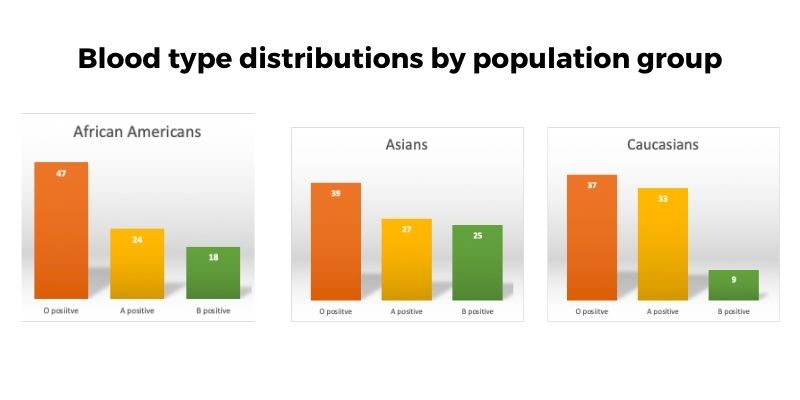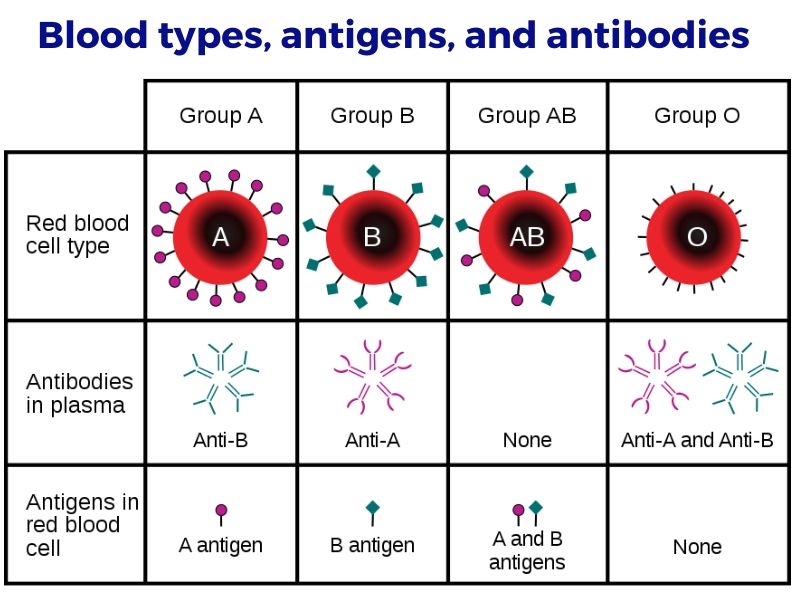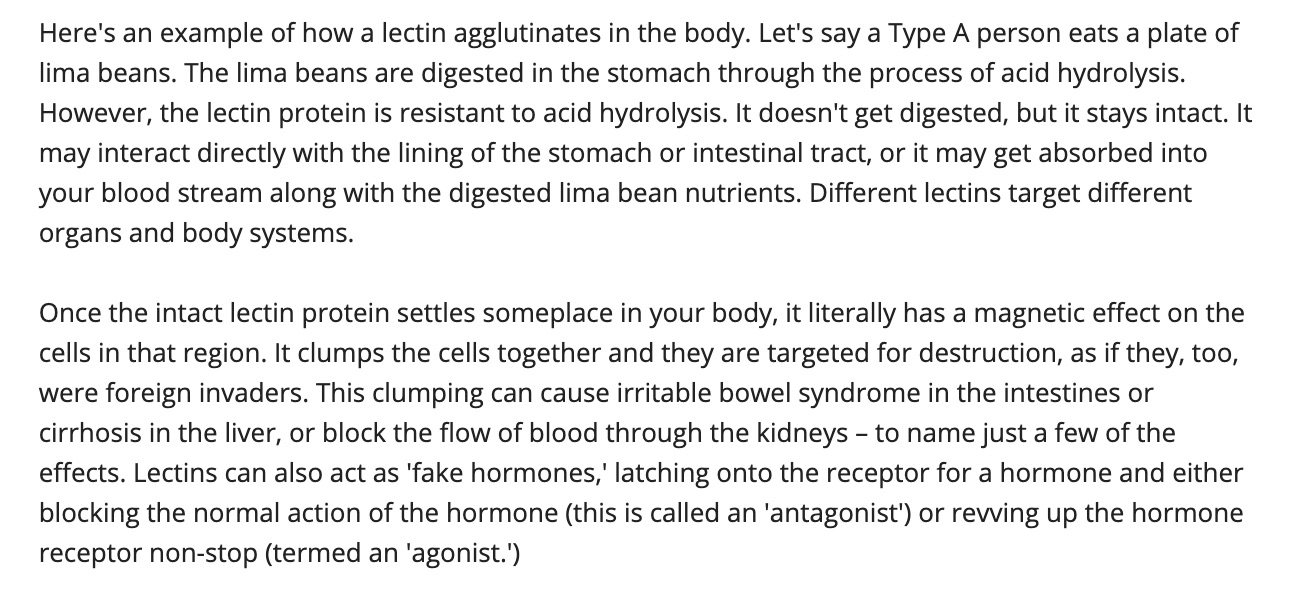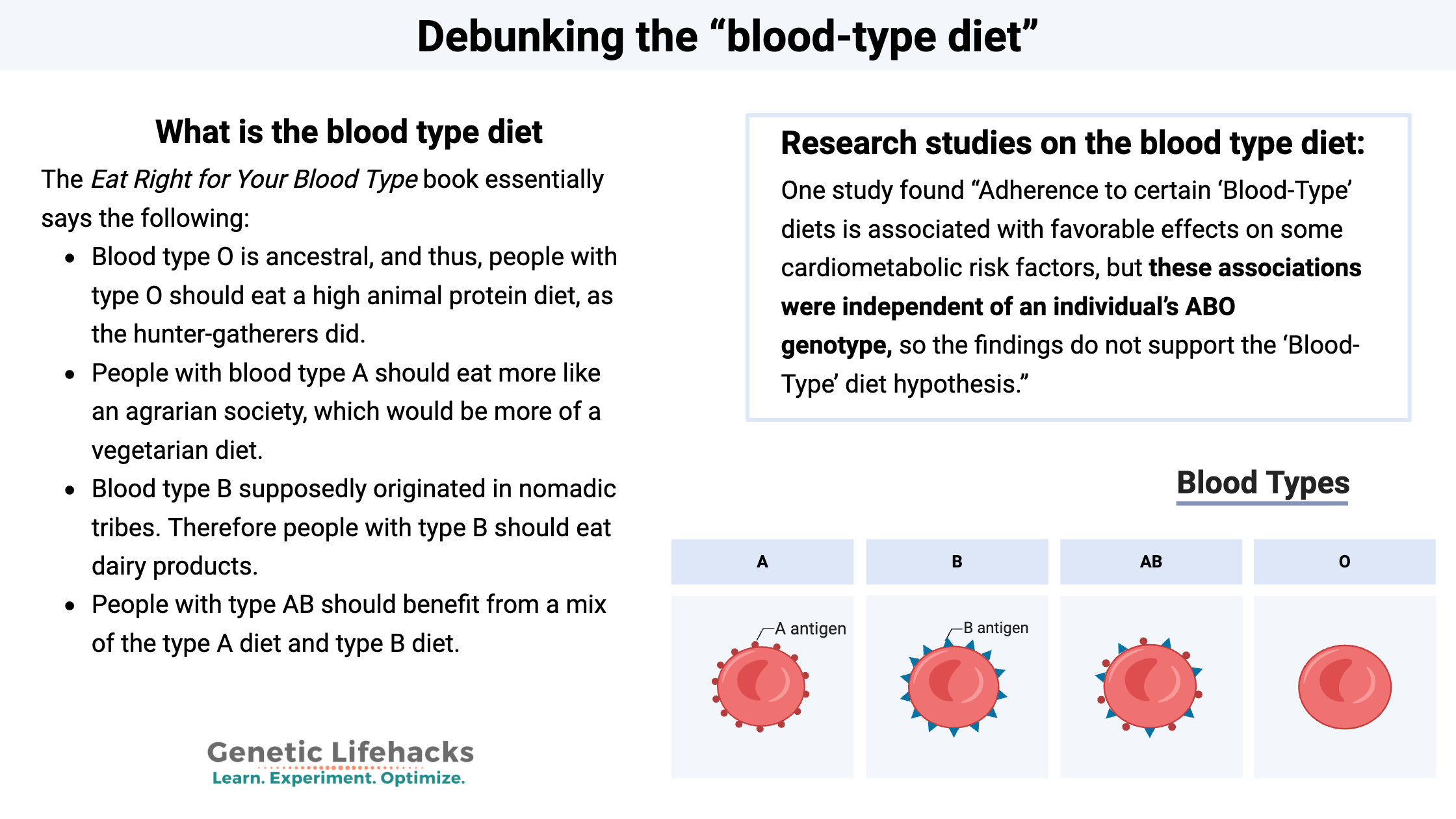A question I’m often asked is whether the ‘blood-type diet’ is based on good genetic research. People comment, “I have to eat a lot of meat because I’m type O blood”. And some even ask things like: “Can blood type O eat eggs?”.
Is there a best diet for you based entirely on your blood type? Does having a specific blood type mean that you can’t eat certain foods? This is a review of the concept of eating for your blood type — backed up by peer-reviewed research studies.
TL;DR: Not a lot of current research supports the concept….
What is the blood type diet?
This diet is based on a popular book from 1996, Eat Right for Your Blood Type by Dr. D’Animo, which has sold more than 7 million copies. The premise of the book is that different ABO blood types can predict your best type of diet.
A quick overview of Eat Right for Your Blood Type:
The Eat Right for Your Blood Type book essentially says the following:
- Blood type O is ancestral, and thus, people with type O should eat a high animal protein diet, as the hunter-gatherers did.
- People with blood type A should eat more like an agrarian society, which would be more of a vegetarian diet.
- Blood type B supposedly originated in nomadic tribes. Therefore people with type B should eat dairy products.
- People with type AB should benefit from a mix of the type A diet and type B diet.
The book gets more detailed and gives specific foods to avoid for each blood type. For example:
- Type O should avoid: wheat, corn, navy beans, lentils, kidney beans, dairy
- Type O should eat more: kelp, seafood, red meat, kale, spinach, broccoli, olive oil
Before we get into the science…
Let’s take a common-sense approach to the two core ideas, which are:
- your blood type indicates you should eat what your ancestors ate a hundred thousand years ago
- there are foods you should avoid because they can cause a reaction with your blood type
First common-sense point: There is a mix of blood types in all ethnicities around the world, but the percentages vary a bit. For example, there is a higher percentage of type B+ people who are African American than there are in Caucasian population groups. (data source)

Cool charts, but does this actually matter when it comes to serving up dinner? Nope. There has been a nice mix of blood types in different ancestry groups for thousands of years. Communities and families with different blood types have been eating their meals together throughout history.
Second point:
Next up is the idea that people with specific blood types should avoid specific foods because it will cause an agglutination (clumping of cells) reaction in their blood.
Take the recommendations for type O as an example: The blood type diet claims people with this blood type should avoid wheat, corn, and lentils because they cause negative health consequences such as cirrhosis. This would mean that ~40% of the population, throughout history, should have cirrhosis or other negative health consequences whenever they ate the staple foods of their people (e.g. bread, tortillas, lentils, cheese). While you as an individual may have digestive problems with a specific food, all-in-all these were staple foods that kept our ancestors alive and healthy, passing on their genes to the next generations.
Let’s dig into the heart of the blood type diet science:
Enough of the logical arguments, let’s see what research shows.
One of the core ‘science’ issues here is whether eating foods containing lectins interacts with a person’s blood type, causing an agglutination reaction where the cells clump together.
This is at the core of the blood type diet recommendations, and the lectin component is a theory that is still going around today, in one form or another.
Let me first explain blood types, and then I’ll dig into the different lectins.
Science background: ABO blood type
The surface of your red blood cells contains glycoproteins coded for by the ABO gene. These proteins determine your ABO blood type. (There are actually a bunch of different blood type antigens, but the ABO blood group is the most well-known and most important for transfusion and transplant reactions.)
Austrian physician Karl Landsteiner first wrote about blood groups in 1900. He found that there were three types of blood (which he called A, B, and C), and mixing up the types could cause an adverse reaction where the red blood cells clump together. Landsteiner was awarded the Nobel Prize in 1930 for discovering blood groups.
What does your blood type mean?
- If you have type A blood, the surface of your red blood cells contains the A antigen composed of a sugar molecule and a protein. By about one year of age, people with type A blood will be producing antibodies against type B blood.
- If you have type B blood, the surface of your red blood cells contains the B antigen composed of a sugar molecule and a protein. By about one year of age, people with type B blood will be producing antibodies against type A blood.
- For people with type O blood, the surface of the red blood cells doesn’t contain either A or B antigens, but people with type O blood will produce antibodies against both type A and B. (Type O- is the universal donor for transfusions.)
- Finally, the least common blood type is type AB. People with type AB blood produce both A and B antigens on the surface of red blood cells. But, they don’t produce antibodies against A or B. (Type AB is the universal receiver for transfusions)

The A antigen or B antigen on red blood cells are glycoproteins the immune system can recognize and interact with. If you carry the A antigen on your red blood cells, your immune system recognizes this as ‘self’. Other antigens, though, are found on the cell membranes of bacteria or other pathogens, triggering your immune system to attack.[ref]
Going a little bit deeper:
While we talk about the four blood types (A, B, AB, and O), there are really 8 common types and about 72 less common ABO genetic variants. Common types include A1, A2, B1, A1B1, A2B1, O1, O1v, and O2.[ref] In organ transplant, the two common types of A (A1, A2) are often not compatible.[ref]
What happens when you mix blood types?
Someone with type A blood will have anti-B antibodies. If the type A person gets a blood transfusion from someone with type B blood or type AB blood, then the type A person’s anti-B antibodies will bind to the type B blood, causing an immune reaction that clumps the blood cells together. This can be deadly, depending on the amount of blood transfused.
Is blood type O the ancestral type?
Another core principle in the blood type diet book from 1996 was that type O blood was likely ‘ancestral’ and thus people with this type should eat like hunter-gatherers. Current research by evolutionary biologists shows that this simply isn’t true. Many mammalian species evolved with A/B blood types, and one of those is likely ‘ancestral’, although that term doesn’t really work here.[ref]
How could a food protein cause a reaction to a blood type?
A type of protein called a lectin can bind to a carbohydrate (or sugar) molecule. Part of the blood type antigen on the surface of the cell is a sugar molecule. There are specific lectins (some from foods, some from bacteria) known to interact with the A or B antigen on the surface of red blood cells.
Let me explain more about lectins, and then I’ll dive into whether food lectins are likely to be circulating in your bloodstream.
Background science: Lectins
A big part of the blood type diet – in addition to eating meat or grains like a hypothetical ancestral group – is that certain foods are a problem based on blood type. The foods that are a theoretical problem are due to specific lectins in the foods.
Eat Right for Your Blood Type states that eating foods with ‘incompatible’ lectins for your blood type will damage your organs. (source)

For example, people with type O blood are told to avoid wheat, soybean oil, peanuts, and kidney beans because the lectins in these foods cause a reaction with the blood type. Meanwhile, type B blood should avoid chicken, corn, all types of soy, and lentils.
Eating the wrong foods thus causes organ damage in the liver, kidneys, gut, stomach, etc. due to the lectin in that food.
What exactly are Lectins?
You’ll often see articles explaining that lectins are simply a type of protein found in all plants. Raw kidney beans and other legumes are particularly high in lectins, as are uncooked grains.
Lectins are a type of protein that can bind to specific carbohydrates. This binding is specific between the lectin and carbohydrate (like a lock and key) and it is reversible. While we often think of carbohydrates as being foods that we eat (bread, pasta, potatoes), in scientific terms, carbohydrates are just chains of sugar molecules bound together.
Lectins are produced by plants, animals, bacteria, archaea, protists, viruses, and fungi.[ref]
We humans have lectins in our bodies that serve specific functions. For example, mannose-binding lectin (MBL gene) is an important part of the immune system that binds to a particular type of sugar found on the cell membrane of some pathogenic bacteria, viruses, and fungi. (Read more and check your genes in the viral immunity article)
It is true that scientists have known for a long time that specific lectins can react with the A-antigen or B-antigen on the surface of red blood cells. For example, if you add the lectin extracted from uncooked lima beans to a drop of type A blood, you will see an agglutination reaction. Lectins from raw kidney beans can also cause agglutination reactions. (Cooking beans, instead of eating them raw, inactivates the lectins.)
The question is – how many of these specific lectins survive cooking, avoid digestion, and are taken into the bloodstream? The premise of the blood type diet seems to hinge on these lectins somehow circulating in our bloodstream, getting into the liver to cause cirrhosis or into the kidneys to cause a blockage.
The book gives this explanation:

First, who eats a plate full of lima beans? Ick… My distaste for lima beans aside, let’s go through how nutrients get absorbed in the intestines.
When you eat something with protein in it, the food is first broken down in the stomach and then moved into the intestines for further digestion. The lining of the intestines is made up of several different cell types, including enterocytes that bring nutrients into the body. These cells are covered by a layer of mucous and a thin layer of glycoproteins, glycolipids, and enzymes that finish the digestion process.
In the intestines, protein (whether from an animal or plant) breaks down into amino acids for absorption by the enterocyte cells. Most proteins don’t get absorbed intact…
Lectins are harder to break down, which is why we cook foods that are high in lectins (beans, grains). Cooking beans and legumes eliminates the lectins.[ref][ref]
In people with serious intestinal permeability issues, such as in alcoholics, the tight junctions between the cells in the intestines can loosen – allowing some macromolecules and bacteria or viruses access to the bloodstream. So yes, the possibility exists for a lima bean lectin molecule to enter the bloodstream from undercooked lima beans eaten by someone with intestinal permeability issues. But those same people with significant intestinal permeability issues, such as long-term alcoholics, will also have intestinal bacteria entering the bloodstream and going to the liver. Researchers do think that intestinal bacteria play a role in cirrhosis, while there isn’t any research showing that lima bean consumption causes cirrhosis.[ref]
To sum up: Cooking beans and grains eliminates their lectin content. For lectins to be zipping around in your bloodstream, they have to make it through many barriers in your intestines.
Research studies on the blood type diet:
There have been a couple of published research studies on the “Eat Right for Your Blood Type” diet that clearly show that blood type doesn’t make a difference when it comes to diet.
One study concluded: “Adherence to certain ‘Blood-Type’ diets is associated with favorable effects on some cardiometabolic risk factors, but these associations were independent of an individual’s ABO genotype, so the findings do not support the ‘Blood-Type’ diet hypothesis.”[ref]
Another research study on the blood type diet concluded: “No evidence currently exists to validate the purported health benefits of blood type diets.”[ref]
The research studies found that the whole-food diet advice (and cutting out junk food) is a healthy change for anyone. However, there was no correlation to the blood type. Simply put: the whole foods-based diet recommended in the book may be very healthy for you – it just doesn’t matter which blood type you have.
Fact-checking the blood type diet website (science section):
Secretor status: (link)
Most people do indeed secrete their blood type, and the blood type antigens will be found in the mucous lining of the digestive tract and lungs, as well as in the saliva. But about 20% of the population, though, are ‘non-secretors’. You can check your genetic data to see if you are a non-secretor.
Intestinal alkaline phosphatase (link):

Intestinal alkaline phosphatase (IAP), an enzyme secreted by the enterocytes, regulates mucosal defense in the intestines. It is important in gut health, but the research linking it to the blood types (done in 1980) hasn’t held up for replication in larger studies. IAP levels change due to pathogens, diet, age, and inflammation.[ref][ref] Genetics studies show that the ABO blood group variants account for about 0.3% of the variability in alkaline phosphatase levels.[ref]
Many, many other studies show that the reason people with blood type O are at a decreased risk of cardiovascular disease is due to producing less von Willebrand factor.[ref]
To sum up: IAP is important and interesting (and something I will write about more in-depth soon). However, there are many factors other than blood type that regulate the amount in the intestines.
Conclusion:
Eat Right for Your Blood Type has a lot of flaws when judged by current science –but so do a lot of books written over two decades ago! It is a book and a dietary idea that should be judged based on when it was written.
Can people get healthy and lose weight following the guidance of the blood type diet? Honestly, any diet that prompts you to switch to a whole-food diet that eliminates junk food should improve your health. The included recipes for cooking delicious meals based on whole foods seem great, and if you like the way of eating, then stick with it. Scientific research, though, suggests that it just doesn’t matter what your blood type is — everyone should eat a variety of whole foods and avoid processed junk.
Related Genes and Topics:
Do you carry the Hunter-Gatherer or the Farmer Genetic Variant

